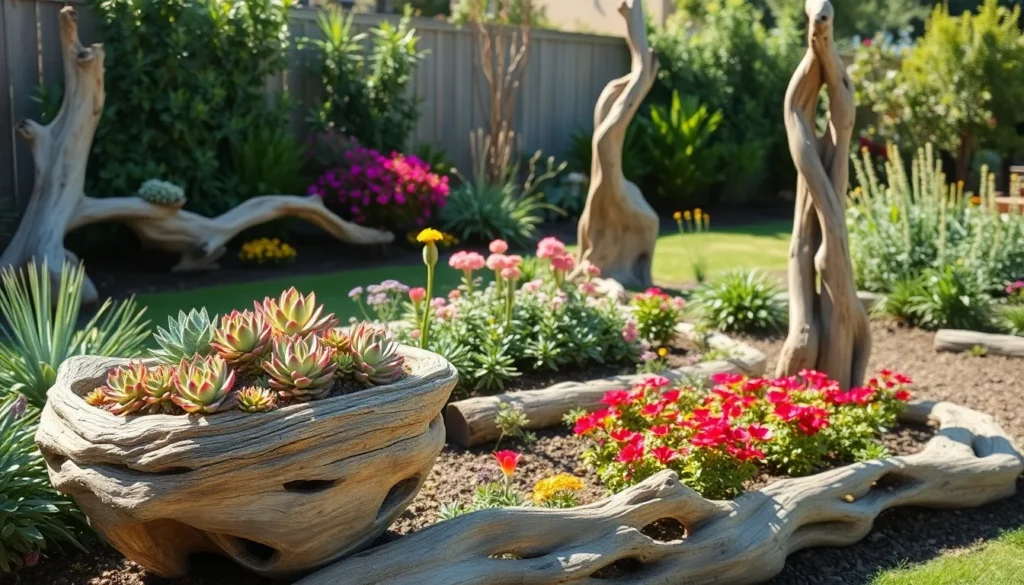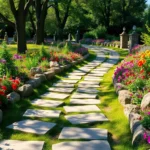Nature’s sculptural masterpieces wash ashore every day but most of us walk right past them. Driftwood – those weathered wooden treasures polished by salt water and time – can transform your garden into a stunning outdoor sanctuary without very costly.
We’ve discovered that driftwood gardening isn’t just about sustainability; it’s about creating unique focal points that commercial garden centers simply can’t replicate. From rustic planters to artistic sculptures these ocean-worn pieces bring an organic elegance that makes neighbors stop and stare.
Whether you’re working with a sprawling backyard or a cozy patio space driftwood offers endless creative possibilities. We’ll show you how to turn these free natural materials into stunning garden features that’ll have your outdoor space looking like a designer retreat in no time.
Create Stunning Garden Borders With Driftwood Edging
Driftwood edging transforms ordinary garden boundaries into organic masterpieces that complement nature’s existing industry. We’ll explore three distinct approaches that showcase how weathered wood creates both functional and beautiful garden borders.
Natural Curved Borders for Flower Beds
Curved driftwood borders work perfectly for perennial flower beds where soft lines enhance the natural growing patterns of plants. We position larger pieces as anchor points every 3-4 feet along the desired curve, allowing the wood’s natural bend to guide our border design. Small driftwood pieces fill gaps between anchors, creating continuous flowing lines that follow the contours of our flower beds.
Layering different sized pieces adds visual depth while preventing soil erosion during heavy rainfall. We select driftwood with varying diameters from 2-6 inches to create interesting height variations that complement both tall delphiniums and low growing sedums. The weathered gray tones provide neutral backgrounds that make colorful blooms like orange marigolds and purple petunias pop against the rustic edging.
Installing curved borders requires minimal ground preparation since driftwood naturally settles into slight depressions we create with a spade. We partially bury each piece 2-3 inches deep to ensure stability while maintaining the organic appearance that makes driftwood edging so appealing for cottage style gardens.
Straight Line Edging for Vegetable Gardens
Straight driftwood edging defines clean boundaries around raised vegetable beds while maintaining the rustic charm that complements homegrown produce. We select uniform pieces ranging from 4-8 feet in length to minimize joints and create uninterrupted lines along our garden rows. These longer sections provide structural integrity that withstands regular foot traffic during harvest seasons.
Positioning straight edging requires careful attention to height consistency to ensure proper water drainage and aesthetic appeal. We use a string line as our guide and partially bury each piece 3-4 inches deep, leaving 6-8 inches above ground to contain mulch and soil amendments effectively. The natural silver patina of weathered driftwood creates striking contrasts against dark composted soil and green vegetable foliage.
Joining driftwood sections becomes seamless when we overlap ends by 6 inches and secure them with galvanized screws hidden beneath the soil line. This technique creates continuous borders that appear as single pieces while providing the flexibility to work around existing trees or garden fixtures like irrigation systems.
Raised Bed Frameworks Using Large Pieces
Large driftwood pieces serve as structural corners for raised beds that can support 12-18 inches of growing medium without additional reinforcement. We choose substantial pieces measuring 8-12 inches in diameter and 4-6 feet in length to create sturdy frameworks that last for decades with minimal maintenance. These impressive specimens often feature interesting knots and grain patterns that become focal points in our garden design.
Building raised frameworks involves notching corner pieces to create interlocking joints that distribute weight evenly across the entire structure. We cut half lap joints using a circular saw and chisel, allowing horizontal pieces to nest securely into vertical corner posts. This traditional joinery technique eliminates the need for metal brackets while showcasing the natural beauty of weathered wood construction.
Filling raised driftwood beds requires quality growing medium that drains well since the elevated design naturally improves soil aeration. We combine equal parts compost, peat moss, and coarse sand to create lightweight growing medium that won’t stress our driftwood framework. The elevated planting surface reduces bending during garden maintenance while creating impressive visual impact that draws attention from across our outdoor space.
Build Eye-Catching Driftwood Garden Sculptures
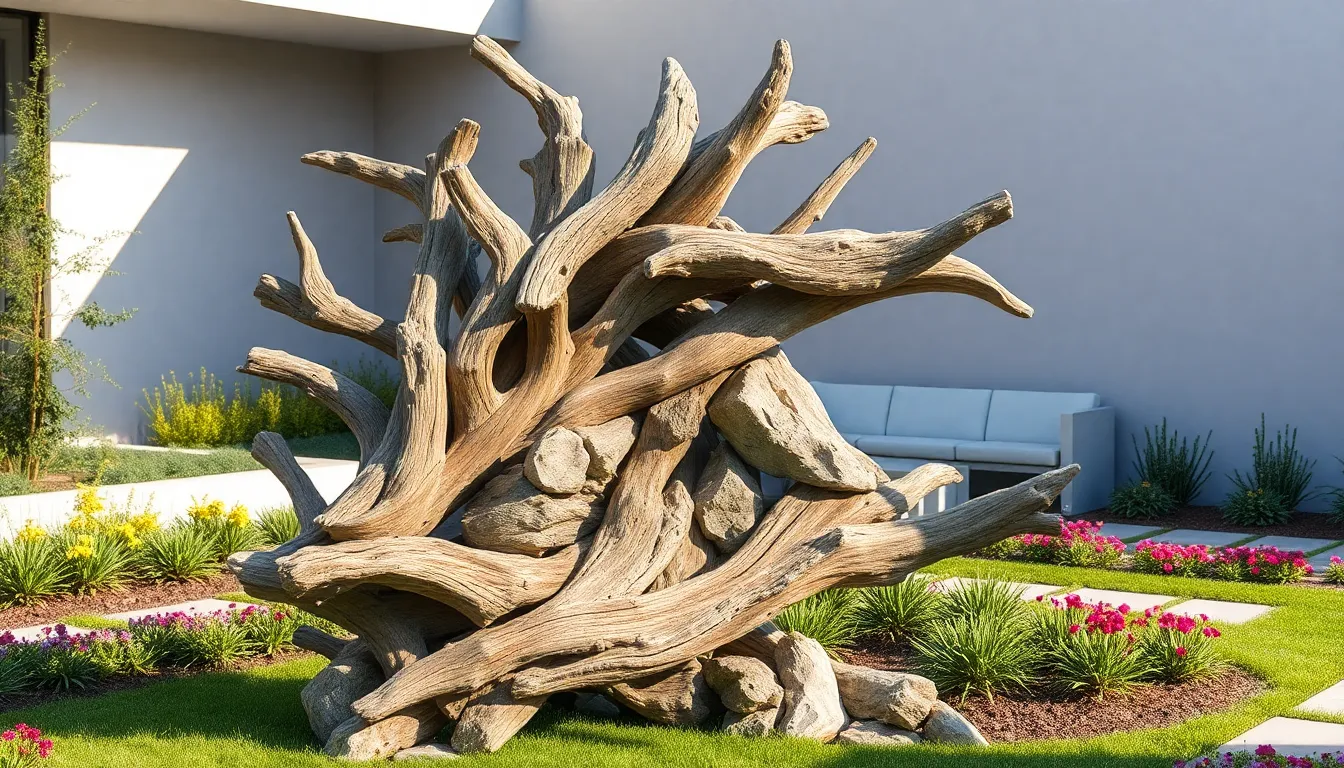
Sculptural elements transform ordinary garden spaces into extraordinary outdoor galleries. We’ll explore three distinctive approaches to creating stunning driftwood sculptures that captivate visitors and enhance your industry design.
Abstract Art Installations for Modern Gardens
Abstract driftwood installations create intriguing focal points that complement contemporary garden aesthetics. We recommend arranging multiple pieces of varying sizes to form ever-changing compositions that catch the eye from different angles.
Combining driftwood with materials like stone or metal enhances visual complexity and adds modern sophistication to your installation. These mixed media sculptures work particularly well in minimalist garden settings where clean lines meet organic forms.
Strategic placement maximizes the impact of your abstract creation. We’ve found that positioning larger installations near seating areas or along main pathways creates natural conversation starters while maintaining the sculpture’s artistic integrity.
Texture becomes a crucial element when designing abstract pieces. Weathered driftwood naturally provides compelling surface variations that change throughout different lighting conditions and seasons.
Animal-Shaped Sculptures for Family-Friendly Spaces
Wildlife themed sculptures bring playful charm to gardens while sparking children’s imagination and curiosity. We suggest starting with simpler forms like birds or rabbits before attempting more complex animal shapes.
Positioning these sculptures near children’s play areas or along garden pathways creates delightful discovery moments for young visitors. Family gardens benefit tremendously from these whimsical additions that encourage outdoor exploration and nature appreciation.
Durability considerations matter when creating animal sculptures for high traffic areas. We recommend selecting pieces with natural joints and curves that support the intended animal form without requiring extensive structural modifications.
Scale appropriately matches your garden space and target audience. Smaller animal sculptures work beautifully in intimate garden corners while larger pieces command attention in expansive lawn areas.
Stacked Tower Sculptures as Focal Points
Vertical tower sculptures draw the eye upward and create dramatic height variations in flat garden landscapes. We construct these towers by carefully balancing driftwood pieces of decreasing size from bottom to top.
Stability becomes paramount when building tall driftwood towers. We secure base pieces firmly in the ground and select naturally interlocking shapes that create stable connections without visible hardware.
Height variations add visual interest to tower designs. Multiple towers of different heights create rhythmic patterns that guide visitors through your garden space while maintaining natural flow.
Wind resistance requires careful consideration during construction. We choose broader base pieces and avoid top heavy configurations that might topple during storms or strong weather conditions.
Design Functional Driftwood Planters and Containers
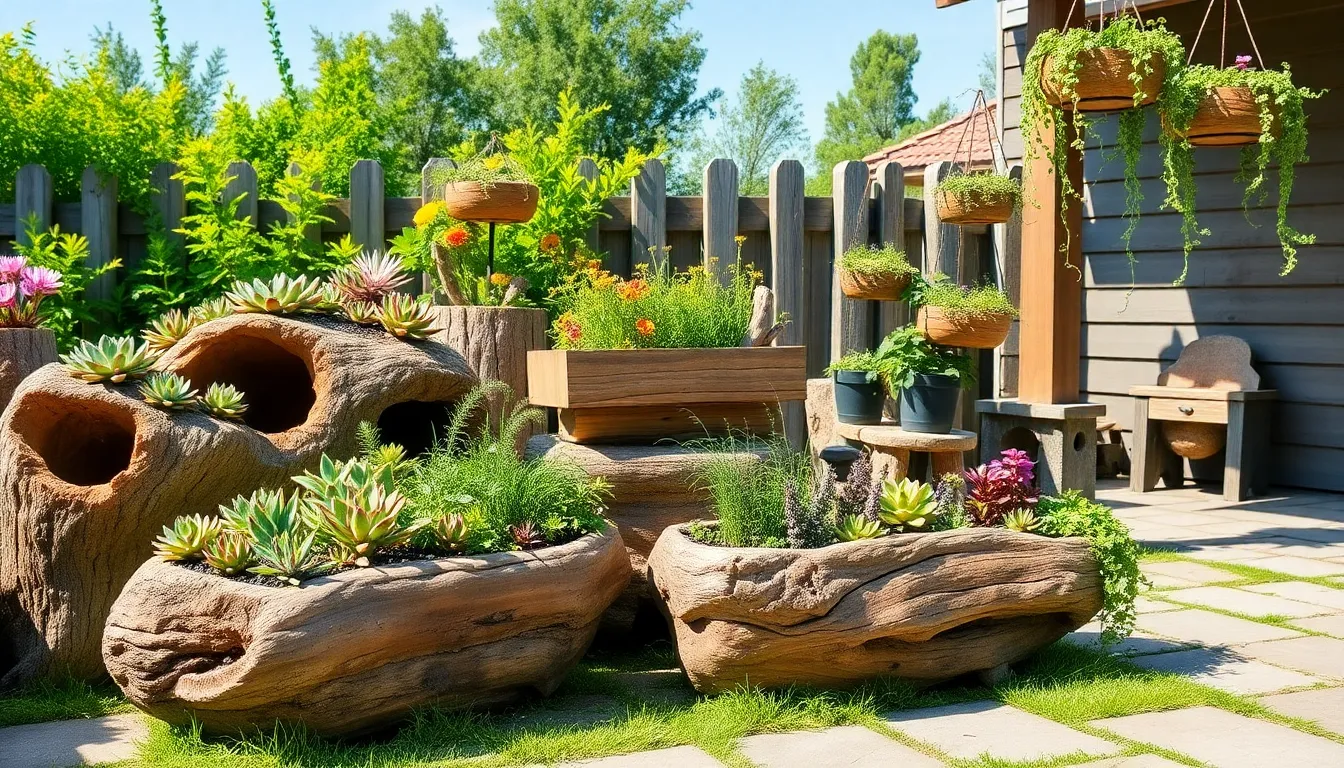
Moving beyond decorative elements, driftwood planters and containers transform weathered wood into practical garden answers. We’ll show you how to create stunning planters that combine rustic charm with garden functionality.
Hollow Log Planters for Succulents
Hollow log planters showcase driftwood’s natural beauty while providing perfect drainage for succulents. We carve out the interior of weathered logs to create unique containers that complement low maintenance plants like echeveria, sedum, and jade plants.
The natural texture of driftwood pairs beautifully with succulent varieties, creating an organic aesthetic that commercial planters can’t replicate. We position these hollow log planters along garden pathways or group them together on patios for maximum visual impact.
Drainage occurs naturally through the porous wood structure, eliminating the need for additional holes. We fill these logs with well draining soil mixed with sand or perlite to ensure our succulents thrive in their new driftwood homes.
Driftwood Box Planters for Herbs
Box planters constructed from driftwood planks offer a rustic solution for growing culinary herbs. We assemble these containers using weathered boards to hold herbs like basil, rosemary, and thyme in organized garden spaces.
The rectangular design maximizes growing space while maintaining the organic appeal of natural wood. We position these herb boxes near kitchen windows or outdoor cooking areas for convenient harvesting during meal preparation.
Construction involves securing driftwood planks with rust resistant screws to ensure longevity in outdoor conditions. We line the interior with industry fabric to retain soil while allowing proper drainage through gaps between the weathered boards.
Hanging Driftwood Planters for Vertical Gardens
Suspended driftwood planters maximize garden space by utilizing vertical growing areas throughout outdoor environments. We hang these unique containers from tree branches, pergolas, or wall mounted brackets to create eye catching displays above ground level.
The hanging design works particularly well for trailing plants like pothos, ivy, and cascading petunias that spill over the edges. We secure rope or chain through drilled holes in the driftwood to ensure safe suspension of planted containers.
Weight distribution becomes critical when designing hanging planters, so we use lighter soil mixes and select appropriately sized driftwood pieces. We space multiple hanging planters at different heights to create layered vertical gardens that draw the eye upward through outdoor spaces.
Construct Driftwood Garden Furniture and Seating
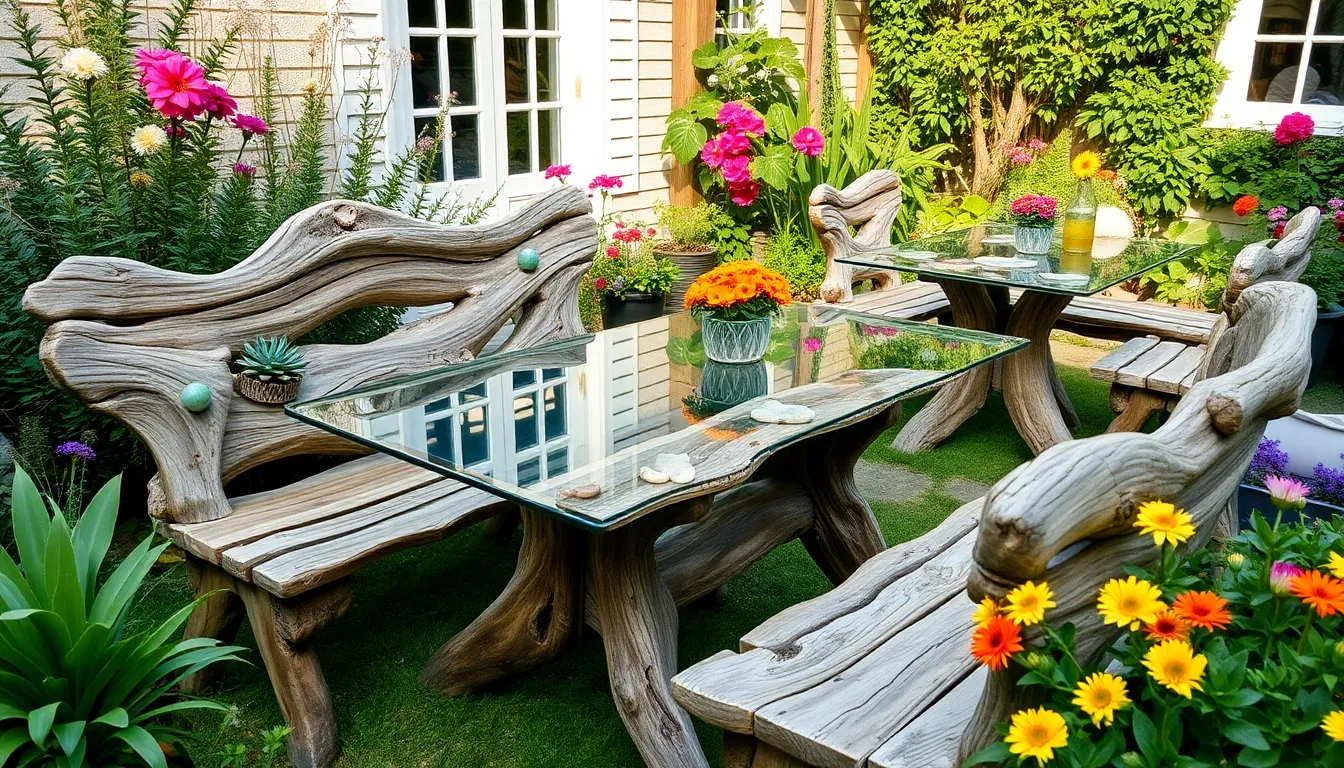
Moving beyond decorative elements, we can transform driftwood into functional furniture pieces that combine coastal charm with practical outdoor living.
Rustic Benches for Garden Pathways
Driftwood benches create inviting rest stops along garden pathways while maintaining that natural aesthetic we’ve been building. Combining multiple driftwood pieces allows us to construct sturdy seating that perfectly complements the rustic borders and planters we’ve already established.
Building these pathway benches requires selecting pieces with similar heights and widths for the frame structure. We enhance existing wooden frames by wrapping them with weathered driftwood, creating an authentic coastal look that weathers beautifully over time.
Adding unique touches transforms basic benches into conversation pieces throughout our garden spaces. Sea glass embedded between driftwood joints catches sunlight while shells pressed into gaps create textural interest that draws visitors closer.
Integrating planters directly into bench designs maximizes our garden’s functionality and visual appeal. Hollow driftwood sections become perfect containers for succulents or herbs, positioning them at arm’s reach while we relax on pathway seating.
Driftwood Tables for Outdoor Dining
Outdoor dining tables crafted from driftwood bring coastal elegance to garden entertaining spaces. Glass surfaces paired with driftwood bases create stunning focal points that complement our existing driftwood borders and sculptures throughout the industry.
Creating these dining surfaces involves combining weathered wood pieces with either glass or wooden tops for durability. We achieve restaurant quality results by carefully selecting driftwood pieces that provide stable support while showcasing the natural grain patterns.
Smaller driftwood pieces serve as decorative accents that enhance the overall dining experience we’re creating. Table runners made from arranged driftwood segments add texture while centerpieces featuring clustered pieces create dramatic visual interest during outdoor gatherings.
Tree Stump Stools With Driftwood Accents
Combining tree stumps with driftwood accents produces unique seating answers that perfectly complement our garden’s natural theme. These hybrid pieces work exceptionally well around fire pits or as additional seating in areas where our driftwood benches might be too large.
Using tree stumps as sturdy bases allows us to add driftwood pieces for both decoration and functionality. We create side tables by attaching flat driftwood sections to stump tops, providing convenient surfaces for drinks and snacks during outdoor gatherings.
Stool combinations featuring both materials bridge the gap between our existing driftwood elements and traditional garden furniture. These pieces tie together the various driftwood projects we’ve implemented while providing practical seating that guests actually want to use.
Install Driftwood Water Features and Fountains
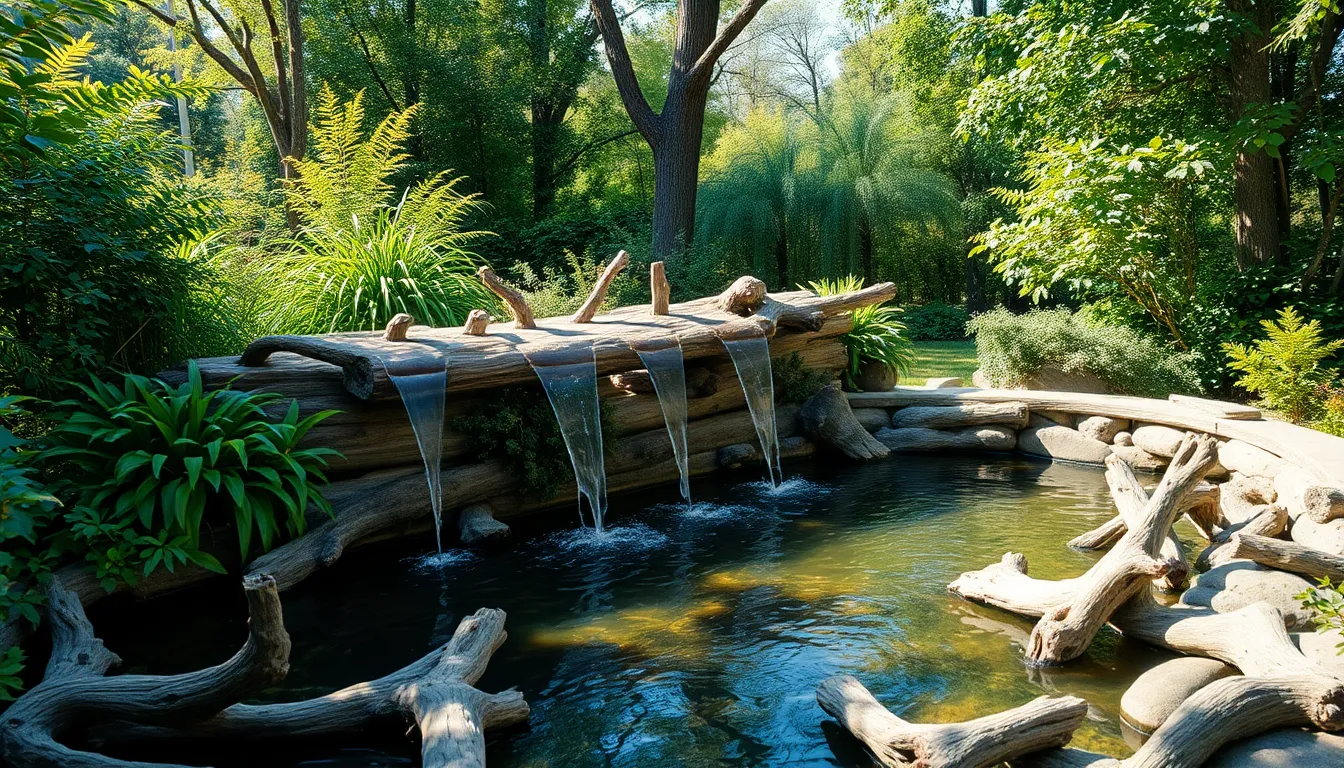
Water features using driftwood pieces transform ordinary garden spaces into tranquil coastal retreats. Our guide shows you how to create stunning fountain installations that capture nature’s artistry.
Simple Driftwood Water Spouts
Building water spouts from driftwood creates rustic focal points that add character to any fountain system. We recommend selecting pieces with natural hollows or drilling small holes to create perfect water outlets that maintain the wood’s organic appearance.
Positioning multiple spouts at different heights generates visually appealing cascades that enhance your garden’s acoustic environment. Smaller driftwood pieces work best for spout construction since they’re easier to secure and maintain proper water flow rates.
Installation involves connecting each spout to your fountain’s pump system using flexible tubing hidden behind or within the driftwood structure. The weathered texture of driftwood provides natural grip points for mounting hardware while maintaining an authentic coastal aesthetic.
Multilevel Driftwood Fountain Designs
Creating multilevel fountains requires large driftwood pieces that can support water weight while providing stable foundation points. We’ve found that combining various sized pieces creates ever-changing water movement patterns that produce soothing sounds throughout different garden zones.
Each fountain level should feature distinct water elements like spouts or cascades to maximize the auditory and visual impact. Design your levels to complement the natural curves and angles of your driftwood pieces rather than forcing them into predetermined shapes.
Structural stability becomes crucial when building multilevel designs since water pressure and weight distribution affect long term performance. Connect levels using hidden supports while allowing the driftwood’s natural beauty to remain the primary visual element.
Pond Borders Enhanced With Driftwood
Driftwood pond edging creates natural transitions between water features and surrounding industry elements. We arrange pieces of varying shapes and sizes along pond perimeters to establish organic borders that frame water surfaces beautifully.
Strategic placement of driftwood pieces serves dual purposes by providing visual interest and anchoring systems for water cleaning plants. Positioning larger pieces at pond bottoms helps maintain plant stability while contributing to overall water clarity and network health.
Edge installations work best when driftwood pieces follow the pond’s natural contours rather than creating rigid geometric patterns. This approach maintains the weathered wood’s inherent character while establishing cohesive design elements throughout your water garden space.
Craft Driftwood Garden Lighting Solutions
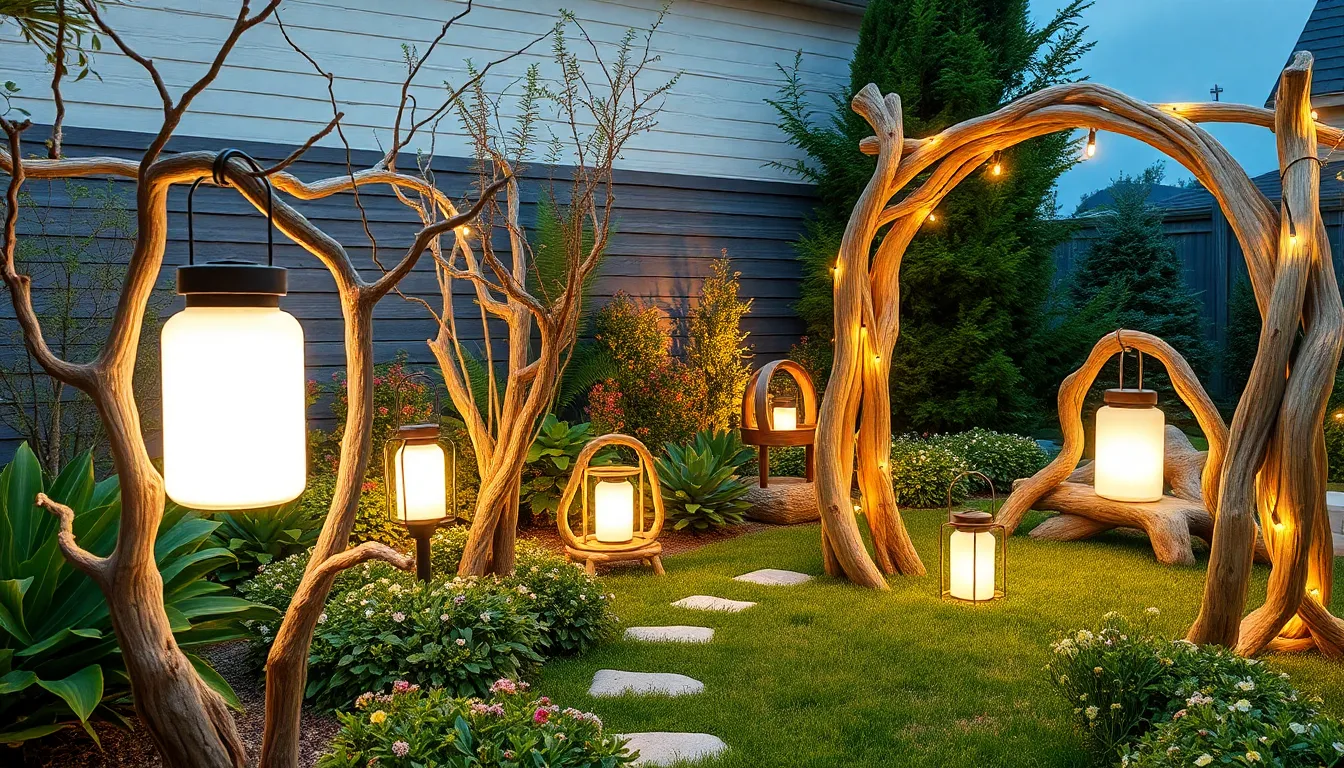
Driftwood’s organic, weathered texture makes it an ideal foundation for creating custom garden lighting fixtures. The natural curves and branched formations provide perfect frameworks for illumination projects that enhance your outdoor space’s rustic coastal charm.
Solar Light Integration in Driftwood Pieces
Solar lights embedded in driftwood branches create sustainable illumination without wiring or electricity costs. We recommend mounting small LED solar bulbs directly into hollowed sections of larger driftwood pieces, allowing the natural wood grain to frame the gentle glow. Stakes can be inserted through smaller branches to create pathway markers that charge during the day and automatically illuminate at dusk.
These eco-friendly installations highlight the weathered beauty of driftwood while providing practical lighting answers. Position solar-integrated pieces near seating areas or along garden paths where guests can appreciate both the sculptural form and functional illumination. The combination enhances nighttime garden aesthetics while maintaining environmental sustainability.
Lantern Holders Made From Branched Wood
Branched driftwood naturally forms ideal supports for hanging or resting lanterns throughout your garden space. We create these holders by selecting pieces with sturdy horizontal branches that can safely support lantern weight. Curved sections work perfectly for creating custom brackets that cradle glass or metal lanterns at optimal viewing heights.
Stability becomes crucial when designing lantern holders from driftwood, so we anchor larger pieces firmly in the ground or against existing structures. Multiple branches on a single piece allow for varied lantern placement, creating layered lighting effects that add whimsical coastal charm to patios and walkways. These holders can accommodate different lantern styles while maintaining the organic aesthetic that makes driftwood so appealing.
String Light Frames Using Curved Driftwood
Curved and arch-shaped driftwood pieces serve as stunning natural frames for string light installations. We drape garden string lights over the organic curves or weave them through multiple branches to create enchanting illuminated sculptures. These installations add dimensional texture while providing warm ambient lighting for outdoor gatherings.
Strategic placement of curved driftwood frames creates magical lighting zones throughout your garden space. Anchor points at both ends ensure the driftwood remains stable while supporting the string lights’ weight. The combination of weathered wood textures with soft, warm bulbs transforms ordinary spaces into cozy outdoor retreats that guests will remember long after evening gatherings end.
Create Driftwood Garden Pathways and Walkways
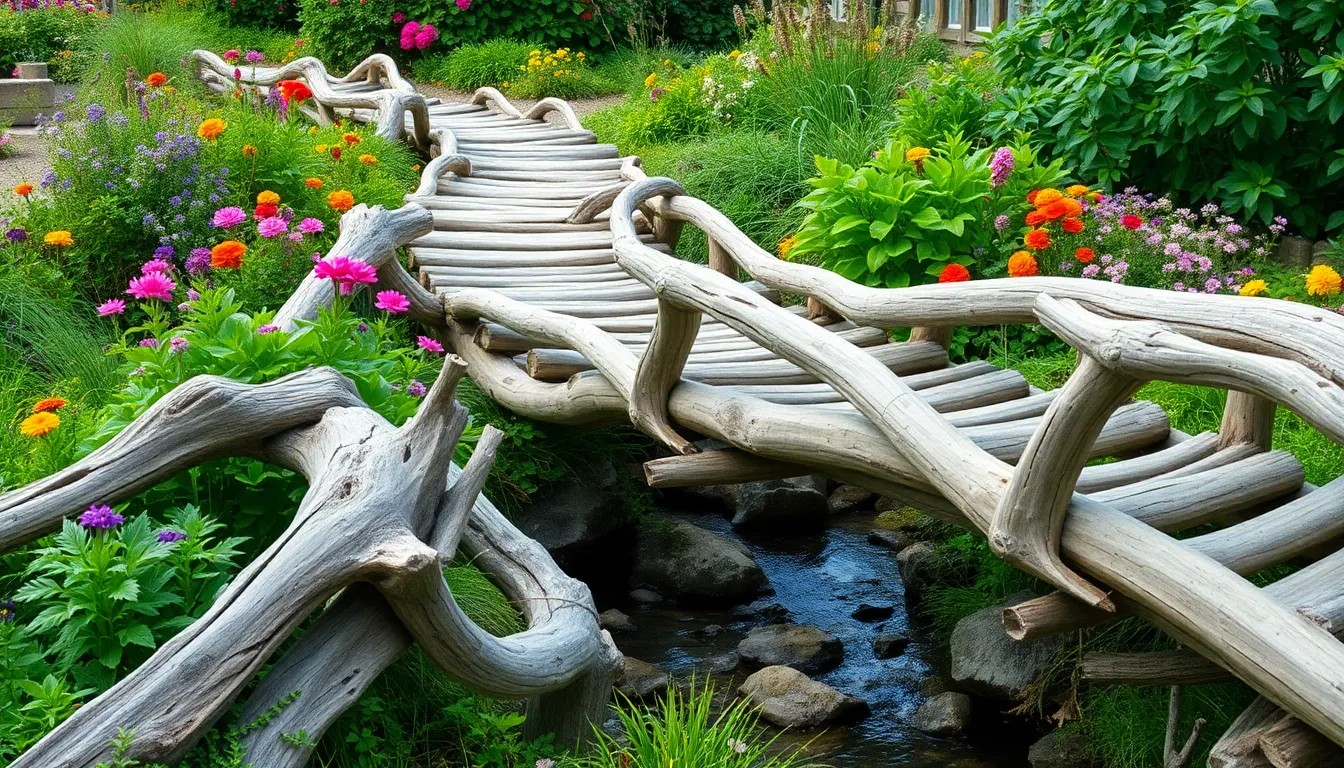
Driftwood pathways bring natural coastal charm to our garden spaces while creating functional walkways that guide visitors through our industry. These weathered wood pieces form organic trails that complement rustic garden designs perfectly.
Stepping Stone Alternatives With Flat Pieces
Flat driftwood pieces create unique stepping stone alternatives that transform ordinary garden paths into artistic walkways. We can arrange these naturally smooth surfaces strategically along our garden routes, providing sturdy footing while maintaining rustic appeal. Their irregular outlines offer character that traditional stepping stones simply can’t match.
Selecting pieces with weathered surfaces ensures durability and slip resistance for safe passage through our gardens. We should position flat driftwood sections approximately 18-24 inches apart for comfortable walking stride. These eco-friendly alternatives work especially well when contrasted against gravel, mulch, or planted ground cover areas.
Large flat pieces work best for primary pathways where foot traffic is heaviest. We can use smaller fragments to create secondary trails that wind through flower beds or around water features. The natural variation in size and shape adds visual interest while maintaining practical functionality.
Pathway Markers and Directional Signs
Driftwood markers serve as distinctive directional guides that enhance our garden’s wayfinding while preserving natural aesthetics. We can carve plant names, garden directions, or inspirational messages directly into weathered surfaces for personalized touches. Their organic shapes create memorable landmarks that help visitors navigate larger garden spaces.
Positioning these markers at pathway intersections provides clear direction without disrupting the natural flow of our industry design. We should select pieces with flat surfaces or natural indentations that accommodate text or symbols easily. Taller vertical pieces work well as primary directional posts, while smaller fragments can mark individual plant areas.
Paint or wood burning techniques allow us to create permanent markings that withstand outdoor conditions. We can also attach small metal plates with engraved information for more formal garden settings. These markers blend seamlessly with coastal or cottage garden themes while providing practical navigation assistance.
Bridge Designs for Garden Streams
Driftwood bridges offer functional stream crossings that double as sculptural garden features in our water landscapes. We can construct these rustic spans using larger driftwood logs as structural supports and smaller branches for walking surfaces. Their natural forms complement water features while providing safe passage across garden streams.
Building stable bridge foundations requires selecting sturdy driftwood pieces that can support foot traffic safely. We should position larger logs as base supports on either side of the stream, ensuring proper anchoring in soil or stone foundations. Smaller branches can be woven or secured across the span to create reliable walking surfaces.
Design considerations include bridge width, weight capacity, and integration with surrounding plantings. We can add driftwood railings for additional safety and visual appeal, especially for bridges spanning wider water features. These structures become focal points that draw visitors deeper into our garden while serving essential crossing functions.
Develop Driftwood Plant Support Systems
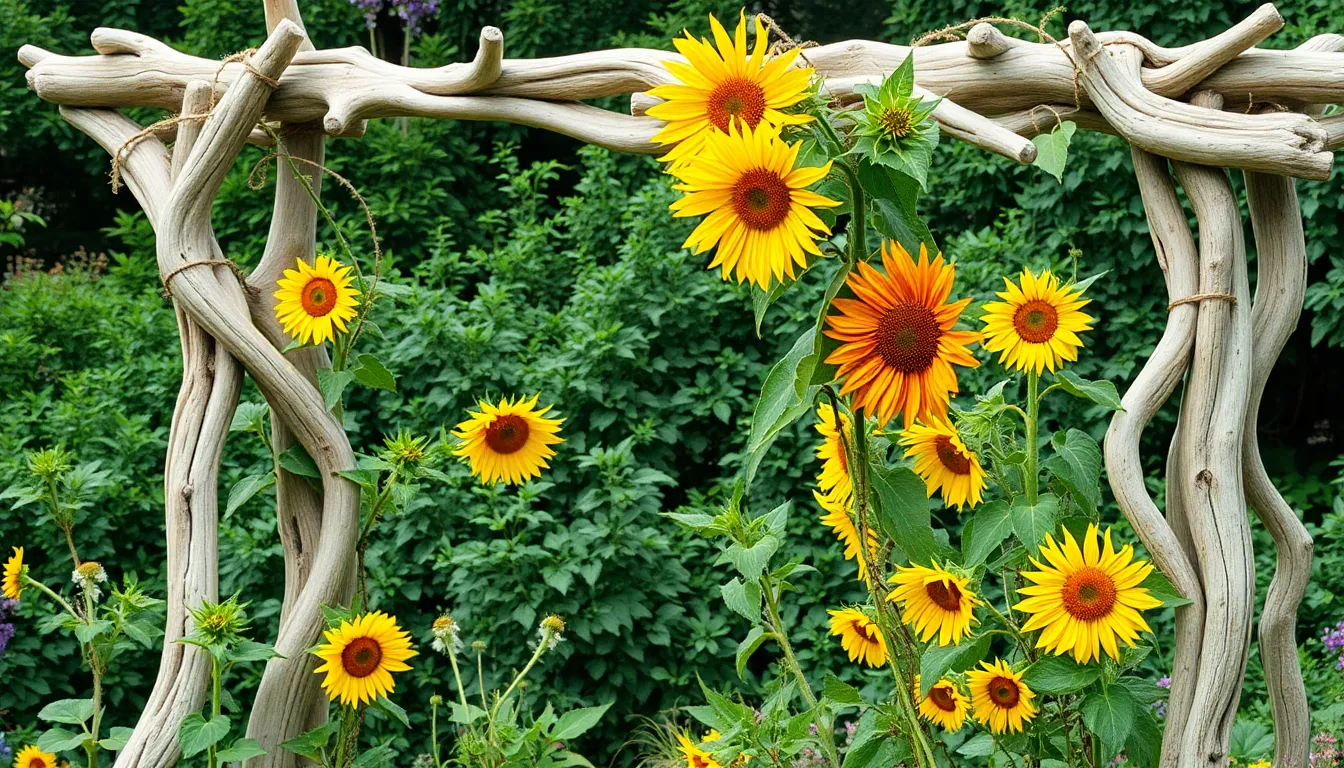
Building on our exploration of decorative and functional driftwood applications, we’ll now focus on creating essential support structures that help your plants thrive while maintaining that coveted natural aesthetic.
Trellis Structures for Climbing Vines
Trellis structures made from driftwood offer stunning backdrops for climbing plants like vines, roses, and clematis. We can create unique vertical supports by connecting weathered branches with natural joints or discrete hardware. Curved driftwood pieces work exceptionally well for creating organic climbing paths that complement the natural growth patterns of vines.
Large driftwood branches serve as primary vertical supports, while smaller pieces create horizontal cross members for plants to grip. We recommend spacing these horizontal elements 8 to 12 inches apart to provide adequate climbing opportunities. Weather resistant joints ensure our trellis structures remain stable through seasons of plant growth and changing weather conditions.
Position these driftwood trellises against walls, fences, or as freestanding garden features to maximize their visual impact. The rustic texture of weathered wood creates beautiful contrast against delicate blooms and lush foliage.
Stakes and Supports for Tall Plants
Stakes crafted from driftwood provide natural support for tall plants like sunflowers and dahlias without disrupting your garden’s organic flow. We select sturdy driftwood pieces that measure 4 to 6 feet in height for optimal plant support. Pointed ends driven 12 to 18 inches into the ground ensure stability against wind and plant weight.
Natural curves and branching patterns in driftwood stakes add character while supporting heavy flower heads and tall stems. We attach plants to these supports using soft ties or natural twine to prevent damage to delicate stems. Multiple stakes can work together to support particularly large or heavy plants throughout their growing season.
Consider the mature height of your plants when selecting driftwood stakes, ensuring the support extends at least two thirds of the plant’s expected height. This approach provides adequate support while maintaining the natural appearance we’re cultivating.
Cage Frameworks for Tomatoes and Vegetables
Cage frameworks constructed from driftwood pieces provide essential structure for tomatoes and other vegetables while adding rustic charm to vegetable gardens. We build these cages using three to four vertical driftwood posts arranged in a circle, connected by horizontal pieces at multiple levels. Standard cage dimensions measure 18 to 24 inches in diameter to accommodate mature tomato plants.
Horizontal support rings created from curved driftwood pieces allow plants to grow through naturally while providing necessary structure. We position these rings at 12 inch intervals up the cage framework to support plants as they develop. Natural branching points in driftwood create perfect attachment spots for connecting horizontal and vertical elements.
These vegetable support cages integrate seamlessly into garden beds while providing the structural integrity that heavy fruiting plants require. Weathered driftwood weathers beautifully through growing seasons, developing an even more attractive patina over time.
Conclusion
We’ve explored countless ways to transform ordinary driftwood into extraordinary garden features that reflect our personal style and creativity. From sculptural installations to functional furniture these weathered treasures offer unlimited possibilities for improving our outdoor spaces.
The beauty of driftwood gardening lies in its accessibility and versatility. Whether we’re creating dramatic water features or simple plant supports each piece tells a unique story while serving our garden’s practical needs.
By incorporating these driftwood ideas we’re not just decorating—we’re crafting sustainable outdoor environments that celebrate nature’s artistry. Our gardens become living galleries where function meets form in perfect coastal harmony.
Frequently Asked Questions
What makes driftwood suitable for garden design?
Driftwood is naturally weathered and shaped by water, making it incredibly durable and resistant to outdoor elements. Its unique textures and organic forms create stunning focal points that can’t be found in commercial garden centers. As a sustainable material, driftwood is also cost-effective and allows for endless creative possibilities in both large and small outdoor spaces.
How can I use driftwood to create garden borders?
Driftwood works excellently for three types of borders: curved borders that enhance flower beds with soft, natural lines; straight-line edging that creates clean boundaries around vegetable gardens; and raised bed frameworks using large pieces as structural corners. Each approach maintains rustic charm while providing practical garden organization.
What types of driftwood sculptures work best in gardens?
Three popular approaches include abstract art installations that complement modern aesthetics, animal-shaped sculptures that add playful charm for families, and stacked tower sculptures that create dramatic height variations. Abstract pieces work well with mixed media, while animal sculptures encourage children’s nature exploration and towers serve as effective focal points.
Can driftwood be used to make functional planters?
Yes, driftwood makes excellent planters. Hollow log planters provide perfect drainage for succulents, box planters maximize growing space for herbs while maintaining organic appeal, and hanging planters utilize vertical space for trailing plants. The natural drainage properties of weathered wood make it ideal for container gardening.
Is it possible to create garden furniture from driftwood?
Absolutely! Driftwood can be transformed into rustic benches for garden pathways, outdoor dining tables that bring coastal elegance to entertaining spaces, and tree stump stools with driftwood accents. These pieces enhance the natural aesthetic while providing functional seating and surface areas throughout the garden.
How can driftwood enhance water features?
Driftwood creates stunning water features including simple water spouts that add character, multilevel fountain designs for enhanced visual appeal, and natural pond borders that create seamless transitions. The organic texture of driftwood transforms garden spaces into tranquil coastal retreats while complementing existing water elements.
What lighting options work with driftwood in gardens?
Driftwood offers versatile lighting solutions including solar light integration for sustainable illumination, lantern holders that add whimsical charm, and string light frames that create enchanting illuminated sculptures. The organic texture of driftwood naturally complements lighting fixtures while enhancing the nighttime garden atmosphere.
Can driftwood be used for garden pathways?
Yes, driftwood creates unique pathways through flat pieces used as stepping stone alternatives, directional markers for personalized navigation guidance, and bridges for crossing garden streams. These elements provide both functional walkways and sculptural features that guide visitors while maintaining natural coastal charm.
Does driftwood work for plant support systems?
Driftwood makes excellent plant supports including trellis structures for climbing vines using large branches as vertical supports, stakes for tall plants that maintain organic garden flow, and cage frameworks for vegetables like tomatoes. These systems help plants thrive while preserving the garden’s natural aesthetic.

